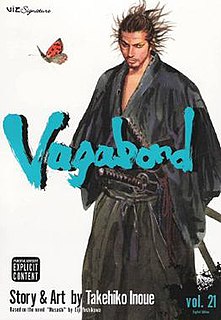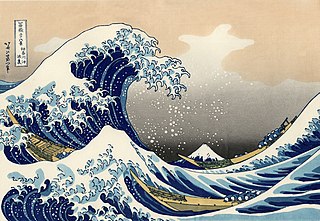
Vagabond is a Japanese manga series written and illustrated by Takehiko Inoue. It portrays a fictionalized account of the life of Japanese swordsman Miyamoto Musashi, based on Eiji Yoshikawa's novel Musashi.
Sasaki Kojirō, often anglicised to Kojirō Sasaki, was a prominent Japanese swordsman widely considered a master of his craft, born in Fukui Prefecture. He lived during the Azuchi–Momoyama and early Edo periods and is most remembered for his death while battling Miyamoto Musashi in 1612.
A jō (杖:じょう) is an approximately 1.27-metre (4.2 ft) wooden staff, used in some Japanese martial arts. The martial art of wielding the jō is called jōjutsu or jōdō. Also, aiki-jō is a set of techniques in aikido which uses the jō to illustrate aikido's principles with a weapon. The jō staff is shorter than the bō. Today, the jō is still used by some Japanese police forces.
The Samurai Trilogy is a film trilogy directed by Hiroshi Inagaki and starring Toshiro Mifune as Musashi Miyamoto and Kōji Tsuruta as Kojirō Sasaki. The films are based on the novel by Eiji Yoshikawa, about the famous duelist and author of The Book of Five Rings.

Musō Gonnosuke Katsuyoshi (夢想權之助勝吉) was a samurai of the early 17th century and the traditional founder of the Koryu school of jojutsu known as Shintō Musō-ryū (神道夢想流/神道無想流). He is perhaps most famous for his duels with the legendary swordsman Miyamoto Musashi.
This is a list of fictional depictions of Miyamoto Musashi, the famous 17th-century Japanese swordsman.

Miyamoto Musashi (宮本武蔵) is a 1954 color (Eastmancolor) Japanese film by Hiroshi Inagaki starring Toshiro Mifune. It is the first film of Inagaki's Samurai Trilogy of historical adventures. The film is adapted from Eiji Yoshikawa's novel Musashi. The novel is loosely based on the life of the famous Japanese swordsman Miyamoto Musashi. The film won a Special/Honorary Award at the 1955 Academy Awards for outstanding foreign language film.

Samurai III: Duel At Ganryu Island is a 1956 color Japanese film directed by Hiroshi Inagaki starring Toshirō Mifune. It is the third film of the Samurai Trilogy. The film is adapted from Eiji Yoshikawa's novel Musashi. The novel is loosely based on the life of the famous Japanese swordsman, Miyamoto Musashi.
Yagyū Hyōgonosuke or — Toshitoshi (利厳) was the founder of the Owari mainline of the Yagyū Shinkage-ryū style of swordsmanship in the early Edo period. He was a son of Yagyū Toshikatsu and a grandson of Yagyū Muneyoshi (Sekishūsai). His name is sometimes mispronounced as Toshiyoshi, but the kanji 厳 reading was passed down as "toshi" in the Yagyū family. His Zokumyō was originally Chūjirō, and his Kaimyō was Jo'un-sai ; though he is mostly remembered as Hyōgonosuke.
Nakamura Ichiroemon a notable swordsman during the Edo period of Japan. Ichiroemon had been primarily renowned for being the senior disciple of the famous lancer, Hōzō-in Inei. After the monk known as Inei deemed his vocation not of the martial arts, Inei passed all of his weapons on to Ichiroemon. One student of note that later become one with Ichiroemons's school of Hozoin, was Takada Matabei. Throughout many years afterwards, Ichiroemon would remain as the leader of the Hozoin school of swordsmanship, training Matabei to his fullest in the art of the lance.
Hayashi Shiryu was a notable swordsman during the Edo period of Japan. Shiryu originally was a student of the Hyōhō Niten Ichi-ryū style of swordsmanship before becoming a disciple under the famous Miyamoto Musashi. Before Shiryu had joined Musashi, he had dueled with him in a dojo. Musashi defeated him, in which he even lost consciousness after leaving the dojo. After reflecting on their duel, Musashi felt that Shiryu had shown considerable talent in the way he had fought, and thus his students took care of his recovery. Shiryu from then onward became a student under Musashi after he had completely recovered. After Musashi left the Owari region, Shiryu continued to study under the guidance of Takemura Yoemon, one of Musashi's senior students. After some time, Shiryu eventually received the final transmission of the Enmei ryu.
Miyake Gunbei was a vassal who served Honda Tadamasa, the lord of the Himeji castle during the Edo period of Japan. Nothing is known of his early life. His primary notability is due to an encounter with the famed swordsman, Miyamoto Musashi.
Ujii Yashirō a retainer under the Japanese clan of Hosokawa during the Edo period of Japan. Lord Hosokawa Tadatoshi had previously practiced the Yagyū Shinkage-ryū art of the sword, in which the principal sword master of the fief was none other than the renowned swordsman, Yashiro. Tadatoshi had at one time wanted for Yashiro to duel against the famous swordsman, Miyamoto Musashi. Musashi had hesitated when hearing this, because Ujii had precedence of rank over him within the fief and had the status of master. However, they both finally agreed to have a duel against each other. During their duel, Yashiro had fought within the presence of his lord, who had sent away all other vassals, with the exception of one, who was to bear his sword. After the two adepts had fought for three rounds, Yashiro could not defeat Musashi in any way, who did not even yet deliver a blow. When taking into the account of Tadatoshi, Musashi had contented himself with dominating Yashiro by rendering the whole of techniques as ineffective. Tadatoshi himself had fought Musashi after this duel, in which he had later said after never being able to deliver a single blow of his sword, "I never imagined there could be such a difference in levels of accomplishment!.

Matsui Okinaga also known as Nagaoka Sado was a Japanese samurai who served the Hosokawa clan, during the early Edo period. It was Nagaoka Sado himself who had protected Miyamoto Musashi as for him to be able to duel against the famous Sasaki Kojirō in 1612. At one time on the battlefield during the year of 1638, Musashi had met Sado. Sado had known at the time that Musashi was living in the house of Ogasawara, but he had learned that it was Musashi's son, Miyamoto Iori who had been under the service of the Ogasawara, and that Musashi was there as a guest. Sado had also learned that Musashi had no true intention of entering under the lord's service, and that he was only taking part in that battle as a staff in order to be an advisor to his son. After Sado had then returned to the province of Higo, he began planning the steps to get Musashi into the service of his fief, since he had already known that Lord Hosokawa Tadatoshi was interested in him. However, Tadatoshi had been previously schooled in the wisdom of the feudal system, in which he ordered for Musashi to act prudently, because Musashi's current situation as he had known, was residing within the house of Ogasawara, in relation to the fact that it would be a major mistake to show discourtesy.
Miyamoto Mikinosuke a retainer of the Japanese clan of Honda during the Edo period of Japan. Mikinosuke was famous for being the first of three adopted sons of the famous swordsman Miyamoto Musashi. One day Miyamoto Musashi had been traveling on horseback along the Settsu road. At a certain inn at Nishinomiya, Musashi had seen a boy of fourteen or fifteen who had taken Musashi's horse for him. Musashi had perceived extraordinary qualities from this boy—Mikinosuke. Musashi then asked the boy, "Wouldn't you like to become my son? I would find a good lord for you.". Mikinosuke replied, "You are very kind to make such an offer, but I have old parents. The reason I am working as a hostler is to take care of them. If I became your adoptive son, my parents would immediately fall on hard times. I must therefore tell you no, with my thanks.". Musashi had then gone to Mikinosuke's house and met his parents. Musashi then had explained his plans to them, receiving their consent to adopt him. He then took Mikonosuke with him after giving a small sum or supportive money to his parents.
Iba Hideaki was a famed swordsman during the Edo period of Japan. Hideaki had been an adept of the Shinkage-ryū at an early age, but later concluded to himself that the school had not reflected realistic fundamentals, which is why he then chose to travel around and look for a school that would better fit him. Hideaki had then followed in a certain duel with an unknown swordsman skilled within the Enmei-ryū in the Kyūshū region. Hideaki had lost the duel, in which he chose to become a disciple under the man that had defeated him. Years later, Hideaki would change his name to Iba Zesuiken, in which Hideaki founded the Shingyōtō-ryū school of swordsmanship in 1682, which was basically a merging of the Shinkage and Enmei's way of the sword. The name of Hideaki's school had meant "School of the Sword That Shapes the Mind". What Hideaki had truly meant by having such a name was the fact that within the time of combat, one will be amongst two states of mind—that of attacking the opponent or fleeing out of fear. Through this, Hideaki employed the principle that one should always attempt to deepen their level of technical accomplishment in order to create within themselves an unshakable form.
Tsutsumi Hōzan (堤宝山), also known as Tsutsumi Yamashiro no kami Hōzan (堤山城守宝山), was a swordsman during the Sengoku period of Japan, who founded Hōzan ryū.
Yoshioka-ryū (吉岡流) is a koryū Japanese sword-fighting martial art and is part of the Kyohachi-ryū. The Yoshioka-ryū became famous during the latter half of the 16th century when Yoshioka Kenpo was assigned to be the sword instructor of the Ashikaga shōguns in Kyoto.
Shinmen Munisai, also called Miyamoto Muninosuke, was a martial artist, expert in using the sword and the jutte. He was also the father of the samurai named Miyamoto Musashi. He was the son of Miyamoto Musashi no kami Yoshimoto, a vassal of Shinmen Iga no Kami, the lord of Takayama Castle in the Yoshino district of Mimasaka Province. Munisai was relied upon by Lord Shinmen Sokan,the head of the Shinmen clan and so was allowed to use the Shinmen name. He was one of the few to have obtained the title of "Unrivaled Under The Sun", title offered to him by the Shōgun Ashikaga.







